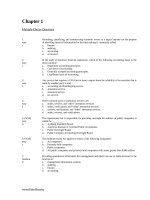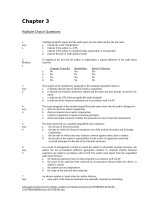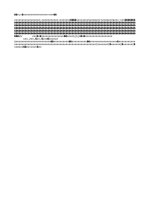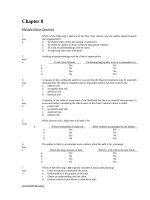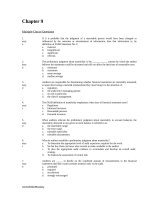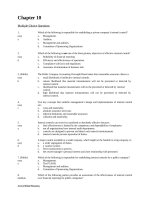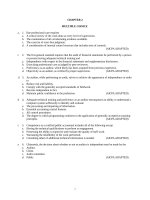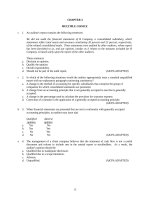Test bank auditing and assurance principles by arens, elder beasley chapter 22
Bạn đang xem bản rút gọn của tài liệu. Xem và tải ngay bản đầy đủ của tài liệu tại đây (126.99 KB, 15 trang )
Chapter 22
Multiple-Choice Questions
1.
easy
b
Which of the following statements is correct?
a. Bonds are frequently issued by companies in small amounts.
b. There are relatively few transactions in the capital acquisition and repayment cycle, and each
transaction is typically highly material.
c. A primary emphasis in auditing debt is on existence.
d. Audit procedures for Notes Payable and Interest Income are often performed simultaneously.
2.
easy
c
The
a.
b.
c.
d.
3.
easy
b
Which of the following is not an objective of the auditor’s examination of notes
payable?
a. To determine whether internal controls are adequate.
b. To determine whether client’s financing arrangements are effective and efficient.
c. To determine whether transactions regarding the principal and interest of notes are properly
authorized.
d. To determine whether the liability for notes and related interest expense and accrued liabilities
are properly stated.
4.
easy
c
Which of the following statements regarding the capital acquisition and
repayment cycle is true?
a. Relatively few transactions affect the cycle, and most are smaller amounts.
b. Large numbers of transactions affect the cycle, and most are smaller amounts.
c. Relatively few transactions affect the cycle, and most are highly material.
d. Large number of transaction affect the cycle, and most are highly material.
5.
easy
a
The
a.
b.
c.
d.
6.
easy
a
Responsibility for the issuance of new notes payable should be vested in the:
a. board of directors.
b. purchasing department.
c. accounting department.
d. accounts payable department.
7.
easy
c
Which of the following accounts is not audited within the capital acquisition
and repayment cycle?
a. Notes payable.
b. Interest expense.
c. Accounts payable.
d. Bonds payable.
8.
The auditor’s independent estimate of interest expense from notes payable
capital acquisition and repayment cycle does not include:
payment of interest.
payment of dividends.
payment of vendor invoices.
acquisition of capital through interest-bearing debt.
primary focuses of the audit of debt are:
accuracy and completeness.
accuracy and existence.
completeness and valuation.
accuracy and valuation.
Arens/Elder/Beasley
easy
a
uses average interest rates and:
a. average notes payable outstanding.
b. year-end notes payable outstanding.
c. only notes payable above the level of materiality.
d. only notes payable to major lenders.
9.
easy
c
The tests of details of balances procedure which requires the auditor to trace
the totals of the notes payable list to the general ledger satisfies the objective
of:
a. accuracy.
b. existence.
c. detail tie-in.
d. completeness.
10.
easy
b
The audit objective to determine that notes payable in the schedule actually exist is verified by the
test of details of balances procedure to:
a. foot the notes payable list.
b. confirm notes payable.
c. recalculate interest expense.
d. examine the balance sheet for proper disclosure of noncurrent portions.
11.
easy
c
Tolerable misstatement is often set at a(n) _____ level for notes payable.
a. high
b. moderate
c. low
d. unknown
12.
easy
c
When auditing interest-bearing debt, the auditor should ______ verify the related interest expense
and interest payable.
a. not
b. attempt to
c. simultaneously
d. never
13.
easy
d
Which of the following accounts would not normally be seen in the equity section of the balance
sheet?
a. Donated capital
b. Dividends declared
c. Common stock
d. Accrued revenue
14.
medium
a
Which one of the following is not a characteristic of the capital acquisition and repayment cycle?
a. The exclusion of a few transactions is rarely material by itself.
b. There is a legal relationship between the client and the holder of the equity securities.
c. There is a direct relationship between the interest and dividends accounts and debt and equity.
d. Relatively few transactions affect the account balances, but each transaction is often highly
material in amount.
15.
medium
c
Which of the following statements is true?
a. There is an inverse relationship between the interest and dividends accounts and debt and
equity.
b. There is no relationship between the interest and dividends accounts and debt and equity.
Arens/Elder/Beasley
c.
d.
There is a direct relationship between the interest and dividends accounts and debt and equity.
None of the above is true.
16.
medium
d
Assessed control risk and results of substantive tests of transactions are normally unimportant for
designing tests of details of balances for which of the following accounts?
a. Accounts receivable.
b. Inventory.
c. Accounts payable.
d. Notes payable.
17.
medium
b
In the audit of the transactions and amounts in the capital acquisitions and repayments cycle, the
auditor must take great care in making sure that the significant legal requirements affecting the
financial statements have been properly fulfilled and:
a. any violations are reported to the SEC.
b. are adequately disclosed in the financial statements.
c. must issue a disclaimer if they haven’t been fulfilled.
d. any departures from the agreements are made with management’s knowledge and consent.
18.
medium
d
Which of the following is an auditor least likely to consider in determining the appropriate tests of
details of balances for notes payable?
a. Business risk.
b. Inherent risk.
c. Results of analytical procedures.
d. Acceptable audit risk.
19.
medium
c
Which of the following audit tests would provide evidence regarding the balance-related audit
objective of existence for an audit of notes payable?
a. Examine due dates on duplicate copies of notes.
b. Examine balance sheet for proper presentation and disclosure of notes payable.
c. Examine corporate minutes for loan approval.
d. Foot the notes payable list for notes payable and accrued interest.
20.
medium
a
Which of the following balance-related audit objectives is not applicable to the audit of notes
payable?
a. Realizable value.
b. Detail tie-in.
c. Cutoff.
d. Classification.
21.
medium
b
When there are not numerous transactions involving notes payable during the year, the normal
starting point for the audit of notes payable is:
a.
a schedule of notes payable and accrued interest prepared by the audit team.
b.
a schedule of notes payable and accrued interest obtained from the client.
c.
a schedule of only those notes with unpaid balances at the end of the year prepared by the
client.
d.
the notes payable account in the general ledger.
22.
medium
d
When there are numerous transactions involving notes payable during the year, the auditor will
likely:
a.
prepare a schedule of notes payable and accrued interest prepared.
b.
review a schedule of notes payable and accrued interest obtained from the client.
c.
request the client to prepare a schedule of only those notes with unpaid balances at the end of
the year.
d.
perform some other procedure.
Arens/Elder/Beasley
23.
medium
b
The tests of details of balances procedure which requires the auditor to examine notes paid after
year-end to determine whether they were liabilities at the balance sheet date is an attempt to satisfy
the audit objective of:
a. existence.
b. completeness.
c. accuracy.
d. classification.
24.
medium
c
Which of the following owners’ equity transactions do corporations not record in their accounting
systems?
a. Issuance of cash dividends.
b. Issuance of preferred stock.
c. Sale of common stock on the secondary market.
d. Each of the above is recorded.
25.
medium
b
The audit of owners’ equity of public and private companies is very different. Which of the
following is not one of these differences?
a. The number of transactions (private companies have fewer transactions).
b. Payment of dividends (public companies rarely pay dividends).
c. Complexity of transactions (public companies generally have more complex transactions).
d. Type of noncurrent debt (public companies issue more bonds).
26.
medium
d
The audit objective that requires that existing notes payable are included in the notes payable
schedule is satisfied by performing which of the following audit procedures?
a.
confirm notes payable.
b.
trace the total of the notes payable schedule to the general ledger.
c.
review the notes payable schedule to determine whether any are related parties.
d.
obtain confirmations from creditors who have held notes from the client in the past and are
not currently included in the notes payable schedule.
27.
medium
a
Which of the following owners’ equity transactions usually require specific authorization from a
company’s board of directors?
a.
b.
c.
d.
Repurchase of common
stock
Yes
Yes
No
No
Issuance of common stock
Yes
No
Yes
No
Declaration of dividends
Yes
Yes
No
Yes
28.
medium
b
When a company maintains its own records of stock transactions and outstanding stock, internal
controls must be adequate to ensure that:
a.
actual owners are recorded in the bylaws.
b.
the correct amount of dividends is paid to stockholders owning the stock on the dividend
record date.
c.
the correct amount of dividends is paid to stockholders owning the stock on the declaration
date.
d.
actual owners are recorded in the minutes.
29.
medium
d
The audit objective that requires the auditor to determine that notes payable on the notes payable
schedule are properly classified can be tested by performing the procedure to:
a. confirm notes payable.
b. examine corporate minutes for loan approval.
c. examine notes, minutes, and bank confirmations for restrictions.
Arens/Elder/Beasley
d.
review the notes to determine whether any are with related parties.
30.
medium
c
The amount of time spent verifying owners’ equity is frequently minimal for closely held
corporations because:
a. these companies are so small that it is not necessary to audit the capital section.
b. the few owners all have access to the books so the auditor spends more time on accounts like
liabilities, which affect outsiders.
c. there are few if any transactions during the year for the capital stock accounts, except for
earnings and dividends.
d. there is no public interest in these companies.
31.
medium
d
Which of the following types of owners’ equity transactions would not require authorization by the
board of directors?
a. Issuance of capital stock.
b. Repurchase of capital stock.
c. Declaration of dividends.
d. None of the above.
32.
medium
b
The record of the issuance and repurchase of capital stock for the life of the corporation is
maintained in the:
a. shareholders’ capital stock master file.
b. capital stock certificate record.
c. schedule of stock owners.
d. corporate directory.
33.
medium
d
The record of the outstanding shares at any given time is maintained in the:
a. corporate directory.
b. stock certificate books.
c. schedule of stock owners.
d. shareholders’ capital stock master file.
34.
medium
a
When a dividend is declared by the board of directors, the source for determining who should
receive dividend checks is the:
a. shareholders’ capital stock master file.
b. stock certificate books.
c. common stock account in the general ledger.
d. corporate directory.
35.
medium
d
The authorization of an issuance of capital stock normally includes all but which of the following?
a. Type of stock to be issued.
b. Number of shares to be issued.
c. Date shares are to be issued.
d. Amount of dividend to be paid on shares issued.
36.
medium
d
Any company with stock listed on a securities exchange is required to engage a(n) _________.
a. equity analyst
b. stock transfer agent
c. independent registrar
d. equity placement specialist
37.
medium
c
Which of the following audit objectives is least important in the audit of capital stock and paid-incapital in excess of par?
a. Completeness.
b. Accuracy.
c. Rights and obligations.
d. Presentation and disclosure.
Arens/Elder/Beasley
38.
medium
d
The primary concern in determining whether retained earnings is correctly disclosed on the balance
sheet is:
a. correct calculation of the net income or loss for the year.
b. correct calculation of dividend payments for the year.
c. whether prior-period adjustments have been made correctly.
d. whether there are any restrictions on the payment of dividends.
39.
medium
d
An auditor would most likely verify the interest earned on bond investments by:
a. testing the internal controls over cash receipts.
b. vouching the receipt and deposit of interest checks.
c. confirming the bond interest rate with the issuer of the bonds.
d. recomputing the interest earned on the basis of face amount, interest rate, and period held.
40.
medium
a
What type of audit test will auditors use when testing to see if existing capital stock transactions are
recorded?
a.
b.
c.
d.
Tests of details of balances
No
Yes
Yes
No
Tests of transactions
Yes
No
No
Yes
Tests of controls
Yes
Yes
No
No
41.
medium
a
During the course of an audit, a CPA observes that the recorded interest expense seems to be
excessive in relation to the balance in the long-term debt account. This observation could lead the
auditor to suspect that:
a. long-term debt is understated.
b. discount on bonds payable is overstated.
c. long-term debt is overstated.
d. premium on bonds payable is understated.
42.
medium
a
A company issued bonds for cash during the year under audit. To ascertain that this transaction was
properly recorded, the auditor’s best course of action is to:
a.
trace the cash received from the issuance to the accounting records.
b.
confirm the results of the issuance with the underwriter or investment banker.
c.
verify that the new cash received is credited to an account entitled “Bonds Payable.”
d.
request a statement from the bond trustee as to the amount of bonds issued and outstanding.
43.
medium
d
What type of audit test will auditors use when testing to see if the amounts of capital stock
transactions are accurately recorded?
a.
b.
c.
d.
44.
medium
c
45.
challenging
Tests of details of balances
No
Yes
No
Yes
Tests of transactions
Yes
No
Yes
No
Tests of controls
Yes
Yes
No
No
If a company employs a capital stock registrar and/or transfer agent, the registrar or agent, or both,
should be requested to confirm directly to the auditor the number of shares of each class of stock:
a. surrendered and canceled during the year.
b. authorized at the balance sheet date.
c. issued and outstanding at the balance sheet date.
d. authorized, issued, and outstanding during the year.
When a company has treasury stock certificates on hand, a year-end count of the certificates by the
auditor is:
Arens/Elder/Beasley
a
a.
b.
c.
d.
always required.
not required if treasury stock is a deduction from stockholders’ equity.
required when the company classifies treasury stock with other assets.
required when the company had treasury stock transactions during the year.
46.
challenging
d
In the audit of notes payable, it is common to include tests of principal and interest payments as a
part of the audit of the acquisitions and payment cycle because the payments are in the cash
disbursements journal that is being sampled. It is also normal to test these transactions as part of the
capital acquisitions and repayment cycle because:
a.
it is not unusual for the auditor to duplicate a process, thereby gathering a larger quantity of
evidence.
b.
replicating the evidence will provide the auditor with a higher level of assurance.
c.
the tests done in the acquisitions and payments cycle will look only at the cash credit side so
the tests done in the capital acquisitions and repayment cycle will look at the debit side of
the transaction.
d.
due to the infrequency of these transactions, in many cases no transactions involving notes
payable are included in the sample tests of acquisitions and payments.
47.
challenging
d
It is normal practice to verify all capital stock transactions:
a.
only when the client is small.
b.
that are in excess of a material amount.
c.
if there aren’t very many during the year.
d.
regardless of the controls in existence, because of their materiality and permanence in the
records.
48.
challenging
b
During its fiscal year, a company issued, at a discount, a substantial amount of first-mortgage
bonds. When performing audit work in connection with the bond issue, the independent auditor
should:
a. confirm the existence of the bondholders.
b. review the minutes for authorization.
c. trace the net cash received from the issuance to the bond payable account.
d. inspect the records maintained by the bond trustee.
49.
challenging
b
In connection with the audit of a current issue of long-term bonds payable, the auditor should:
a.
decide whether the bond issue was made without violating state or local law.
b.
ascertain that the client has obtained the opinion of counsel on the legality of the issue.
c.
calculate the effective interest rate to see if it is substantially the same as the rates for similar
issues.
d.
determine whether bondholders are persons other than owners, directors, or officers of the
company issuing the bond.
50.
challenging
a
The auditor can best verify a client’s bond sinking fund transactions and year-end balance by:
a.
confirmation with the bond trustee.
b.
confirmation with individual holders of retired bonds.
c.
examination and count of the bonds retired during the year.
d.
recomputation of interest expense, interest payable, and amortization of bond discount or
premium.
Arens/Elder/Beasley
Essay Questions
51.
easy
What is a note payable?
Answer:
A note payable is legal obligation to a creditor which may be secured or unsecured by
assets and bears interest.
52.
easy
What is the difference between an independent registrar and a stock transfer agent?
Answer:
Companies whose shares are listed on a securities exchange are required to enlist the services of
an independent registrar. The registrar is responsible for making sure that all stock is issued by a
corporation in accordance with the corporate charter and is properly authorized by the board of
directors. The registrar is also responsible for signing all newly issued shares. A stock transfer
agent maintains stockholder records, including transfers of stock ownership. Transfer agents
may also disburse cash dividends to shareholders.
53.
easy
Why are analytical procedures essential for notes payable?
Answer:
They are essential because tests of details for interest expense and accrued interest can
often be eliminated if the results from the analytical procedures are favorable.
54.
medium
What are two important procedures that companies should implement to prevent misstatements in
owners’ equity?
Answer:
Companies should develop:
1. well-defined policies for preparing stock certificates and recording capital stock
transactions, and
2. independent internal verification of information in the owners’ equity records.
55.
medium
What are the two most important balance-related audit objectives in notes payable?
Answer:
Existing notes payable are included (completeness).
Notes payable are accurately recorded (accuracy).
56.
medium
Describe the methodology for designing tests of details of balances for notes payable.
Answer:
The methodology is:
Set materiality and access acceptable audit risk and inherent risk for notes payable.
Assess control risk for notes payable.
Design and perform tests of controls and substantive tests of transactions for the acquisition
and payment, and sales and collection cycle.
Design and perform analytical procedures for notes payable balance.
Design tests of details of notes payable balance to satisfy balance-related audit objectives.
Arens/Elder/Beasley
57.
medium
Decide sample size, items to select for testing, audit procedures, and timing of procedures.
Identify three analytical procedures commonly performed for notes payable.
Answer:
Some possible analytical procedures for notes payable include:
Recalculate approximate interest expense on the basis of average interest rates and overall
monthly notes payable.
Compare individual notes outstanding with the prior year’s.
Compare total balance in notes payable, interest expense, and accrued interest with prior
years.
58.
medium
The starting point for the audit of notes payable is a schedule of notes payable and accrued interest.
Discuss the information typically included in the schedule.
Answer:
The usual schedule includes detailed information of all transactions that took place during the
entire year for principal and interest, the beginning and ending balances for notes and interest
payable, and descriptive information about the notes, such as the due date, the interest rate, and
the assets pledged as collateral.
59.
medium
When a company maintains its own records of stock transactions and outstanding stock, the internal
controls must be adequate to accomplish three purposes. What are these?
Answer:
The three purposes are:
Actual owners of the stock are recognized in the corporate records.
The correct amount of dividends is paid to the stockholders owning the stock as of the
dividend record date.
The potential for misappropriation is minimized.
60.
challenging
Discuss the four characteristics of the capital acquisition and repayment cycle that make it unique
from other cycles.
Answer:
The four characteristics are:
Relatively few transactions affect the account balances, but each transaction is often highly
material in amount.
The exclusion of a single transaction could be material in itself.
There is a legal relationship between the client entity and the holder of the stock, bond, or
similar ownership document.
There is a direct relationship between the interest and dividends accounts and debt and
equity.
Arens/Elder/Beasley
61.
challenging
Discuss the four key controls over notes payable.
Answer:
The four key controls over notes payable are:
Proper authorization for the issue of new notes. Responsibility for the issuance of new
notes should be vested in the board of directors or high-level management personnel,
with signatures of two authorized officials required for all loan agreements.
Adequate controls over the repayment of principal and interest. At the time notes are
issued, the accounting department should receive a copy in the same manner in which
it receives vendors’ invoices and receiving reports. The accounts payable department
should automatically issue checks for the notes when they become due, in the same
manner in which it prepares checks for acquisitions of goods and services.
Proper documents and records. These include the maintenance of subsidiary records
and control over blank and paid notes by a responsible person. Paid notes should be
canceled and retained under the custody of an authorized official.
Periodic independent verification. The detailed note records should be reconciled
periodically with the general ledger and compared with the note holders’ records by
an employee who is not responsible for maintaining the detailed records.
62.
challenging
Discuss the internal controls related to owners’ equity that are of concern to the auditor.
Answer:
Proper authorization of transactions. Material transactions should be approved by the
board of directors, including issuance of capital stock, repurchase of capital stock, and
declaration of dividends.
Proper recordkeeping and segregation of duties. This should include well-defined
policies for preparing stock certificates and recording capital stock transactions, and
independent internal verification of information in the records. Many companies use a
capital stock certificate book and a shareholders’ capital stock master file to improve
control over capital stock transactions.
Independent registrar and stock transfer agent. An independent registrar acts as a
control to prevent the improper issuance of stock certificates. A stock transfer agent
acts as a control over the stock records.
63.
challenging
Discuss the overall objectives of the audit of notes payable.
Answer:
The overall objectives of the audit of notes payable are to determine whether:
The internal controls over notes payable are adequate.
Transactions for principal and interest involving notes payable are properly authorized
and recorded as defined by the six transaction-related audit objectives.
The liability for notes payable and the related interest expense and accrued liability
are properly stated as defined by eight of the nine balance-related audit objectives
(realizable value is excluded).
Arens/Elder/Beasley
64.
challenging
State the four most important audit objectives for capital stock and describe how the auditor
typically verifies each of the four objectives.
Answer:
The four most important audit objectives for capital stock are:
Existing capital stock transactions are recorded (completeness). Confirm with the
registrar or transfer agent whether any capital stock transactions occurred.
Recorded capital stock transactions occurred and are accurately recorded
(occurrence and accuracy). Existence can be tested by examining the minutes of the
board of directors’ meetings for proper authorization. Accuracy can be tested by
confirming the amount with the transfer agent and tracing the amount of the recorded
capital stock transactions to the cash receipts journal.
Capital stock is accurately recorded (accuracy). The ending balance in the capital
stock account is verified by first determining, via confirmation from the transfer
agent, the number of shares outstanding at the balance sheet date. The recorded par
value in the capital account can be verified by multiplying the number of shares
outstanding by the par value of the stock.
Capital stock is properly presented and disclosed (presentation and disclosure). Using
the corporate charter, the minutes of board of directors’ meeting and the auditor’s
analysis of capital stock transactions, the auditor should determine that there is a
proper description of each class of stock. The proper presentation and disclosure of
stock options, stock warrants, and convertible securities should also be verified by
examining legal documents or other evidence of the provisions of these agreements.
65.
challenging
List six accounts in the capital acquisition and repayment cycle commonly found on balance
sheets. What characteristics do these accounts have in common that distinguish them from other
accounts?
Answer:
Balance sheet accounts in the capital acquisition and repayment cycle include:
Notes payable
Contracts payable
Mortgages payable
Bonds payable
Accrued interest
Cash in the bank
Capital stock-common
Capital stock-preferred
Paid-in capital in excess of par
Donated capital
Retained earnings
Appropriations of retained earnings
Treasury stock
Dividends declared
Dividends payable
The unique characteristics of these accounts are:
Arens/Elder/Beasley
Relatively few transactions affect the account balances, but each transaction is often
highly material in amount.
The exclusion of a single transaction could be material in itself.
There is a legal relationship between the client entity and the holder of the stock,
bond, or similar ownership document.
There is a direct relationship between the interest and dividends accounts and debt and
equity.
Other Objective Answer Format Questions
66.
medium
Match six of the terms (a-i) used in the capital acquisitions and repayment cycle with the
descriptions provided below (1-6):
a.
b.
c.
d.
e.
f.
g.
h.
i.
Capital acquisition and repayment cycle
Capital stock certificate book
Closely held corporation
Independent registrar
Note payable
Publicly held corporation
Stock transfer agent
Schedule of notes payable and accrued interest
Stock maintenance agent
d
1.
An outside person engaged by a corporation to make sure that its stock is issued
in accordance with capital stock provisions in the corporate charter and
authorizations by the board of directors.
h
2.
The normal starting point for the audit of notes payable; includes detailed
information of all transactions related to notes payable that took place during the
year.
b
3.
A record of the issuance and repurchase of capital stock for the life of the
corporation.
g
4.
An outside person engaged by a corporation to maintain the stockholder records,
and often to disburse cash dividends.
f
5.
An entity that is required to engage an independent registrar.
a
6.
The cycle that concerns the acquisition of capital resources through interestbearing debt and owners’ equity and repayment of the capital.
67.
easy
a
One unique characteristic of the capital acquisition and repayment cycle is that relatively few
transactions affect the account balances, but each transaction is often highly material in amount.
a. True
b. False
68.
easy
a
The exclusion of a single equity transaction is often highly material.
a. True
b. False
69.
easy
b
Notes payable are generally for short periods of time.
a. True
b. False
70.
easy
a
When performing analytical procedures for notes payable, if actual interest expense is
materially larger than the auditor’s expectation, one possible cause would be interest payments
on unrecorded notes payable.
Arens/Elder/Beasley
a.
b.
True
False
71.
easy
b
Auditors seldom learn about the capital acquisition and repayment cycle when gaining an
understanding of the client’s business and industry.
a. True
b. False
72.
easy
b
The Securities and Exchange Commission requires companies to employ stock transfer agents.
a. True
b. False
73.
easy
b
Public companies whose stock is listed on a stock exchange must employ a stock transfer agent.
a. True
b. False
74.
easy
a
Public companies whose stock is listed on a stock exchange must employ an independent
registrar.
a. True
b. False
75.
easy
a
The shareholders’ capital stock master file is used as the basis for the payment of dividends and
also acts as a check on the accuracy of the common stock balance in the general ledger.
a. True
b. False
76.
easy
b
Independent registrars commonly disburse cash dividends to shareholders.
a. True
b. False
77.
easy
a
Any restrictions on the payment of dividends must be disclosed in the footnotes to the financial
statements.
a. True
b. False
78.
medium
a
When auditing the capital acquisition and repayment cycle, it is common to verify each
transaction taking place in the cycle for the entire year as a part of verifying the balance sheet
accounts.
a. True
b. False
79.
medium
b
Few large companies employ stock transfer agents, but small companies commonly do so.
a. True
b. False
80.
medium
a
The balance-related audit objective realizable value is not applicable when auditing notes
payable.
a. True
b. False
81.
medium
b
The three most important balance-related audit objectives for notes payable are existence,
realizable value, and accuracy.
a. True
b. False
Arens/Elder/Beasley
82.
medium
b
83.
medium
a
The audit procedure “Foot the notes payable list and trace the totals to the general ledger” is
performed when verifying the accuracy objective for notes payable.
a. True
b. False
The accuracy of a dividend declaration can be audited by recalculating the amount on the basis
of the dividend per share times the number of shares outstanding.
a. True
b. False
84.
medium
b
The audit procedure “Examine notes payable, minutes, and bank confirmations for restrictions”
is performed when verifying the classification objective for notes payable.
a. True
b. False
85.
medium
a
For most companies, the only transactions involving retained earnings are net earnings for the
year and dividends declared.
a. True
b. False
86.
medium
b
Examining the minutes of the board of directors’ meetings for proper authorization ordinarily
tests the existence objective for capital stock transactions.
a. True
b. False
87.
medium
a
Examining the minutes of the board of directors’ meetings for proper authorization ordinarily
tests the occurrence objective for capital stock transactions.
a. True
b. False
88.
medium
b
The emphasis in the audit of dividends is on the ending balance rather than the transactions.
a. True
b. False
89.
medium
b
Any company that has more than 10 percent of its stock owned by one person is considered to
be closely held.
a. True
b. False
90.
medium
b
A shareholders’ capital stock master file is a record of the issuance and repurchase of capital
stock over the life of the corporation.
a. True
b. False
91.
medium
b
Capital stock represents a legal obligation to a shareholder and ensures a certain return to the
shareholder.
a. True
b. False
92.
medium
a
The audit procedure “Examine paid notes for cancellation to make sure they are not still
outstanding” is performed when verifying the completeness objective for notes payable.
a. True
b. False
Arens/Elder/Beasley
Arens/Elder/Beasley
